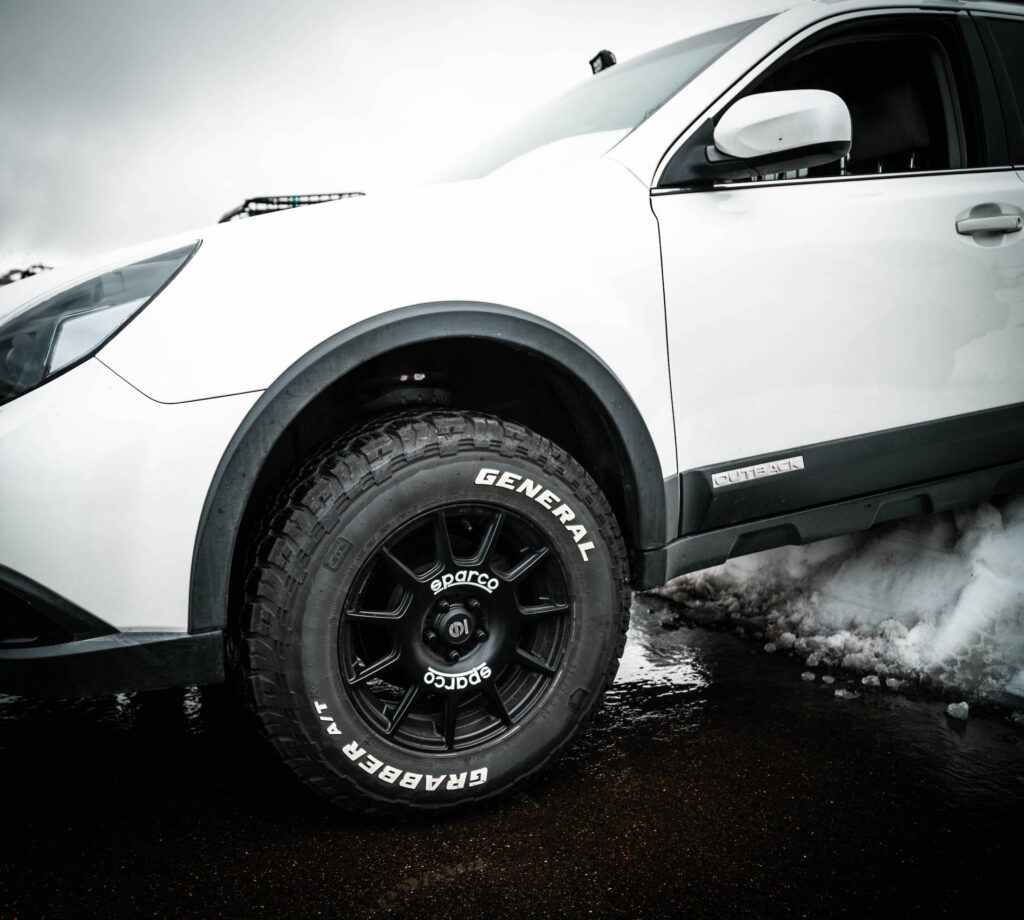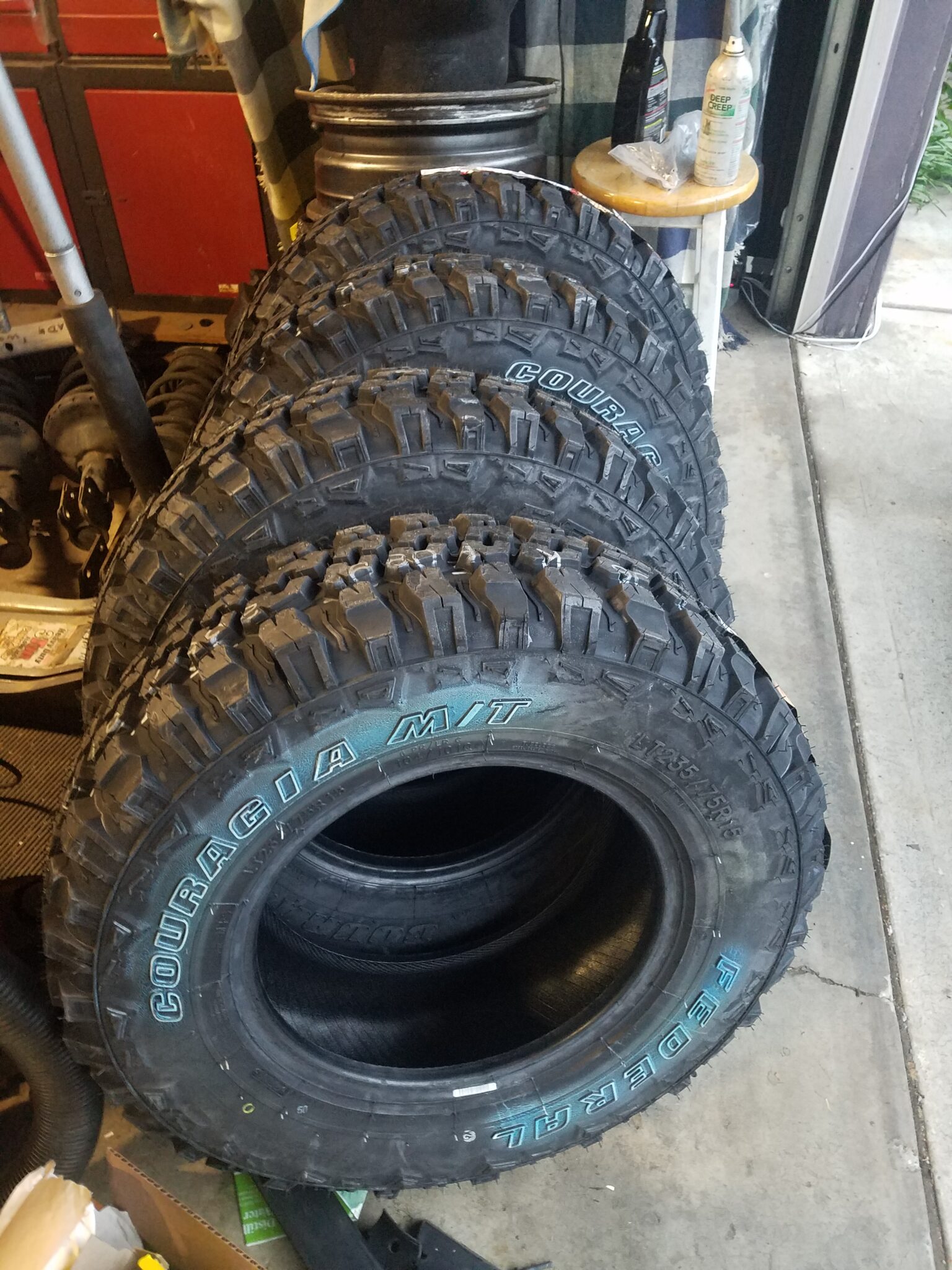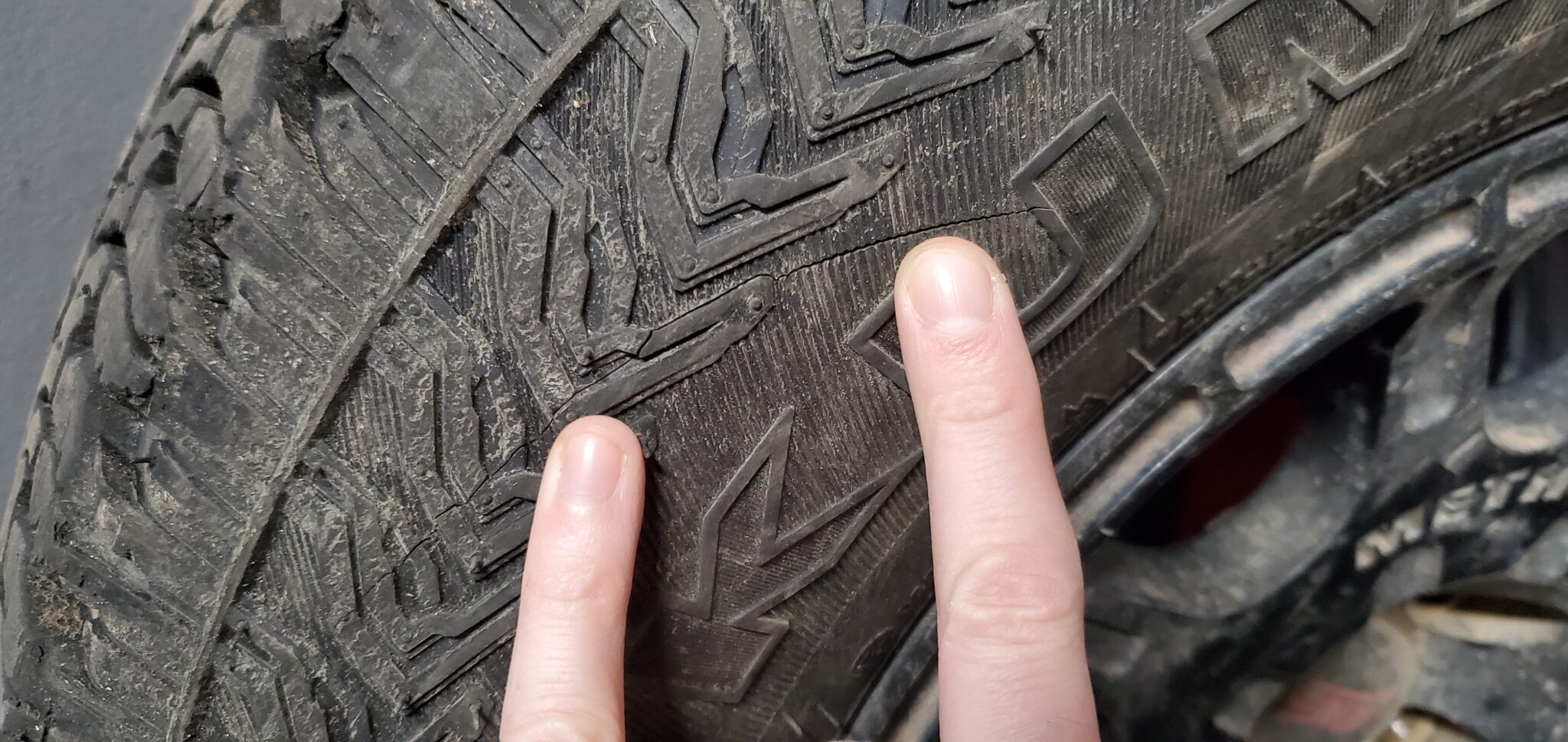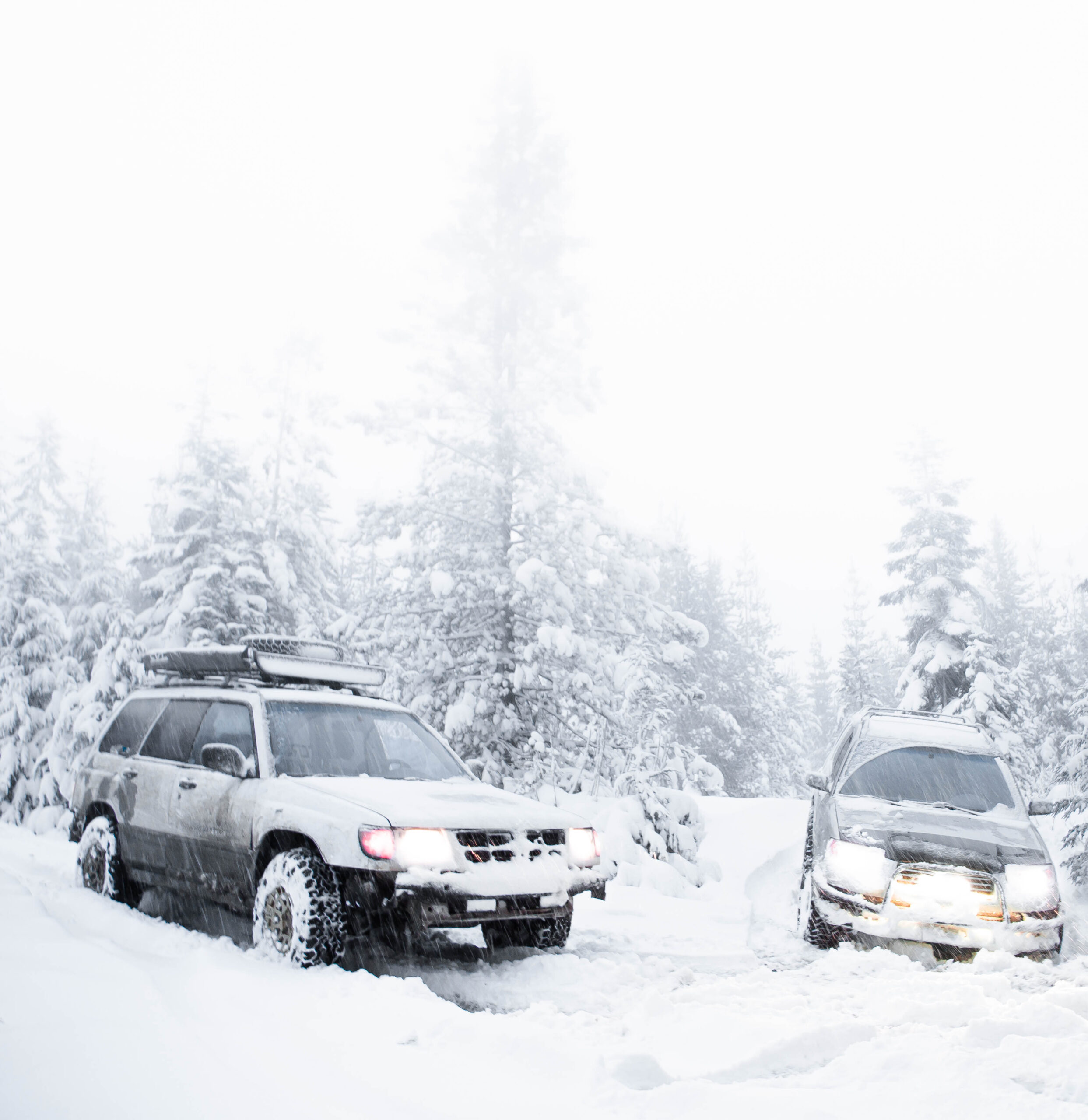
Heading out on off-road adventures in your Subaru is a ton of fun, but one of the main keys to conquering challenging trails is tied to the tire you choose.
In this guide, we’ll explore common mistakes new off-road Subaru enthusiasts often make when purchasing new off-road tires. I’ll share some personal insights to help you navigate the back roads and trails with confidence.
I made plenty of bad tire choices when I initially began off-roading in my old Subaru Legacy. Hopefully by sharing these, you can get the most out of your lifted Subie and save money as you avoid these common pitfalls.
1. Neglecting Tire Size and Type
My first mistake when trying to put a bigger tire on my Subaru was not being educated in the difference between tire types. I’m telling you, I was so uneducated on tire knowledge when I first got into this hobby. I didn’t know that there was anything different between all-terrain and all-season tires.
The first oversized tire I installed on a Subaru was a set of Pirelli all-season tires. I learned this lesson the hard way when a rock tore a massive chunk out of the thin sidewall of those tires. I quickly realized that choosing the right tire type is like finding the perfect hiking boots—critical for adventures in a capable Subaru.
The two types of off-road tires that should be considered for your lifted Subaru are all-terrain tires and mud-terrain tires. All-terrain tires will be aggressive enough for most people.
However, for those who plan to navigate more challenging trails, a set of mud-terrains can be very beneficial. I have run both tire types and prefer my mud terrains for the trails since I can air them down a lot more. But my all-terrains are substantially more comfortable on the pavement while still allowing for mild trail capability.
Choosing the correct tire size is crucial for maintaining ground clearance and preventing rubbing issues. I see a lot of folks make the mistake of not selecting the right rim diameter or overall diameter for the type of off-roading they want to do.
An 18 inch tire with an overall diameter of 29 inches is going to be far less durable on the trails than a meaty 15 inch tire of the same diameter. By simply decreasing the diameter of your wheels, extra sidewall durability can be added to the tire of your choice.
It’s important to recognize that tire size is one of the biggest factors in off-road capability. However, it’s possible to go too big in your tire size. With a tire that is too big and heavy, your Subie will have a difficult time handling the added rotational mass.
I typically try to keep the overall diameter of my new tires around 1 inch bigger than stock and rarely more than 2 inches larger than the OEM tire size. I have had no issues sticking to this rule when buying bigger off-road tires.
Bigger tires also come with the challenge of fitting the new size on the vehicle without rubbing. Sticking around 1 inch bigger is almost always safe. However, for those who are adventurous and simply enjoy pushing the limits, going 2-3 inches larger can be a fun challenge! On one of my current Subarus I have a set of tires installed that are almost 3 inches larger than the stock tires. But there was a lot of hammering and cutting involved that some people may not be willing to do.
While it’s possible to go too big with your new tires, it is also possible to select a tire that’s not big enough for your demands. If you want to run trails that have a lot of rocks and deep ruts, a tire that’s not quite big enough may hold you back while off-roading.
One of the best things you can do if this is a new experience for you is to ask other people in the local community what tires they’re running on the trails near you. This is a great place to start when selecting tire size and making sure you get something big enough. More seasoned locals will have a good idea of what it takes to make your car a bit more capable on the trails you will be driving in the future. In my case, I learned this the hard way.
I started out by running tires that were barely bigger than stock and found myself getting high centered a lot and not being able to climb over bigger obstacles. Once I finally jumped up to a bigger tire, I instantly felt the added capability.
RELATED: not sure if an offroad tire is the right choice? Checkout our “Should I Install All Terrain Tires On My Subaru?” article to determine if it fits your needs.
2. Going With A "Heavy-Duty" Tire

This point may seem counterintuitive. But since our Subarus don’t weigh a lot and most of us will never be towing heavy loads we don’t need a tire that is made for large pickup trucks. In most situations I always look for the non “LT” version of a tire. I look for a tire size that either has nothing in front of it (ie. 235/75R15) or a P (passenger) in front of the size (ie. P235/75R15.) But I always steer away from sizes like “LT235/75R15” simply because my Subaru is not heavy enough to take advantage of the heavy duty carcass. In fact, the bulkier tire construction may actually create more negatives.
I ran a set of 10 ply (E load rating) mud terrains on my first lifted Forester. They were on the car when I purchased it and they were just too heavy for it. Due to the extra thick sidewall, the tires didn’t bulge easily when airing down since the car was so light. They also made the car feel absolutely sluggish. I installed a set of tires that were almost identical in size but in a P-metric version that had a much more manageable construction. This tire was roughly 10 lbs lighter per tire. Immediately after doing this I could feel that the car was much more responsive and it translated directly to being more capable off-road as the car could handle them much easier.
I may get a lot of disagreement from people here. But this has been the absolute best tire buying strategy for me. There are some folks who will prefer to use an LT tire just for the added security of knowing that it will be nearly impossible to damage it on trails. If I was dead-set on an LT tire, I would stick to one with a C load rating and nothing higher. I feel that D load and above are simply too bulky to add any benefit for our Subarus.
3. Going With A Tire That's Not Heavy-Duty Enough

I just talked a lot about trying to avoid using tires that are “overkill” for Subarus. But it’s also possible to buy tires that are too thin and non-aggressive for the type of trails that you intend to tackle. There are some all-terrain tires out there that are fantastic for pavement driving with a less aggressive tread pattern and a lighter duty sidewall. Tires like the Falken Wildpeak AT Trail, the Nitto Nomad Grappler, and the Yokohama Geolandar GO15 are awesome daily drivers that possess the ability to go off-road. However, if a person is planning to do trails that are a bit more on the advanced side, these lighter duty AT’s may not deliver the same grip or sidewall strength that some of the more heavy-duty AT tire options do.
I have helped swap out more than one AT Trail with a blown out sidewall from rock damage. I’ve also experienced the Yokohama Geolandars not evacuating mud fast enough to gain traction on a specific trail while other cars with more aggressive tread had no problem. Each of these tires are great and provide a good on-road experience. However, a person needs to make sure they purchase something heavy duty enough to match their needs.
4. Ignoring Trail and Climate Conditions

Different off-road tires excel in various conditions and terrains. This means we either need to purchase more than one set of tires for different types of weather and terrain, or we have to strategically pick a tire that can do everything we need all at once. But if you take a tire recommendation from someone in Arizona but live in the Northern portion of Washington State, your experience with that tire might be the complete opposite. For a tire that can handle snowy trails, look for tires with the Three-Peak Mountain Snowflake (3PMSF) symbol for good winter performance. If you plan to do “hardcore” 4×4 trails with lots of sharp rocks, a mud terrain with a basic 6 ply (C load rating) sidewall rating should hold up to most harsh trail days.
There are a lot of factors when it comes to selecting a good tire that can “do it all.” If you don’t plan to have two sets of wheels and tires for different seasons, it’s important to do research on your intended tire purchase. Something I like to do when I’m checking out a new tire is to go through the reviews on Tire Rack or another retailer that sells them and use “Control + F” and then search a few keywords that are important to me. For example, there is a lot of sand at the places where I go wheeling. So when I’m buying tires for my Jeep I look in the reviews to see which tires people have had positive sand experiences with.
It’s also a great idea to reach out to the manufacturer or retailer and explain the type of terrain you’re going to be driving in. They may be able to make a good recommendation. When I purchased a set of Kumho Road Venture AT51’s there wasn’t much info on the Tire Rack site for some reason. It may have been relatively new in their system at the time. I contacted Tire Rack and asked a few questions about their cold weather rating, weight, and overall diameter. The guy on the phone actually had someone in the warehouse grab one of the tires and physically measure it for me. Needless to say, after my phone call with them I felt extra confident in purchasing the tires and I still own them to this day (for the record, they do great in the snow.)
5. Focusing Solely On Price
I get it, we’re all trying to get by with what we have. But focusing only on a specific price point when purchasing tires for off-road purposes is a recipe for disaster. When I first started driving off-road I thought I had found a really good deal on a set of used Toyo Open Country AT2’s. They were substantially cheaper than anything in the new market, so I took a chance and purchased them. However, at that time I didn’t know much about how to read sidewall markings, such as DOT date codes. I took them to the tire shop and found that they were only a few months within being too old for them to install per their policy. They also found some damage to the bead on one of the tires that I hadn’t noticed when buying them. Before long, those tires lost the majority of their grip as they had become less pliable with age. They also developed small micro cracks throughout the tire sidewall as well. I replaced them within a year and spent even more money than if I had just bought a good set from the beginning.
Similar to the used market, focusing only on price can be detrimental in the new market as well. If someone needs a tire that can perform well all year round but won’t spend the extra $100 for a reputable tire that is 3PMS rated, that person will likely be disappointed in the long run. Or if a person truly needs a heavy duty mud-terrain tire but purchases a cheaper all-terrain instead, they may find their vehicle far less capable than they need it to be. While tire technology has progressed to a point of being relatively good across the board, it’s still important to figure out what kind of tire you need first. Once you’ve determined your largest needs, developing a budget that can still get you what you need is the best strategy. Remember, your tires are the only part of your vehicle that are creating grip and in constant contact with the ground. Skimping on tire price is the last thing most off-roaders should be doing.
6. Disregarding Tire Ratings and Reviews
I had purchased a mud terrain tire a few years ago and planned to use them for snow wheeling despite the fact that I had read numerous reviews from other people stating things like “this tire is great, but it hardens significantly in the cold weather and has no grip in the snow.” For some reason I was surprised when I found that exact thing to be true. I had to air them down to almost 5 psi in order to maintain good grip in the deep snow out on the trails.
Here are a couple of ways that I’ve gotten specific information on a tire prior to purchase:
- Asking friends who have used them in similar conditions and terrain
- Reading reviews on Tire Rack, Discount Tire, or even Amazon
- Searching through posts of local off-road groups on Facebook
- Checking out different informational sites for ratings and education
- Calling the manufacturer or retailers to ask for general guidance (retailers get to hear a lot of feedback from real users and they get to see which tires are purchased twice by customers)
7. Neglecting Regular Tire Maintenance After Purchase
I’ve been guilty of not rotating mud terrains on a regular basis and then being surprised when they wear unevenly. It can sometimes be hard to stay on top of maintenance. But caring for your new tires is an absolute must if you want them to perform well in the long run. Here are a few things that I always do to care for my tires:
- Rotate on a schedule that at least meets the manufacturers recommended interval. Some people perform rotations every other oil change.
- Get regular alignments after particularly harsh off-road trips. Poor alignment can chew your tires up quickly – especially mud terrains.
- Make sure to rotate in 5th full sized spares where applicable to keep them within the correct tread depth for your Subaru’s AWD system.
- Perform air pressure checks regularly and always reinflate correctly after airing down.
As an off-road Subaru enthusiast, choosing the right off-road tires is more than just a buying choice, it’s a main factor in how well your adventures will go.
Learn from my experiences and prior mistakes so you can save a little money. If you follow these buying tips, you’ll be more likely to make the right tire selection.
